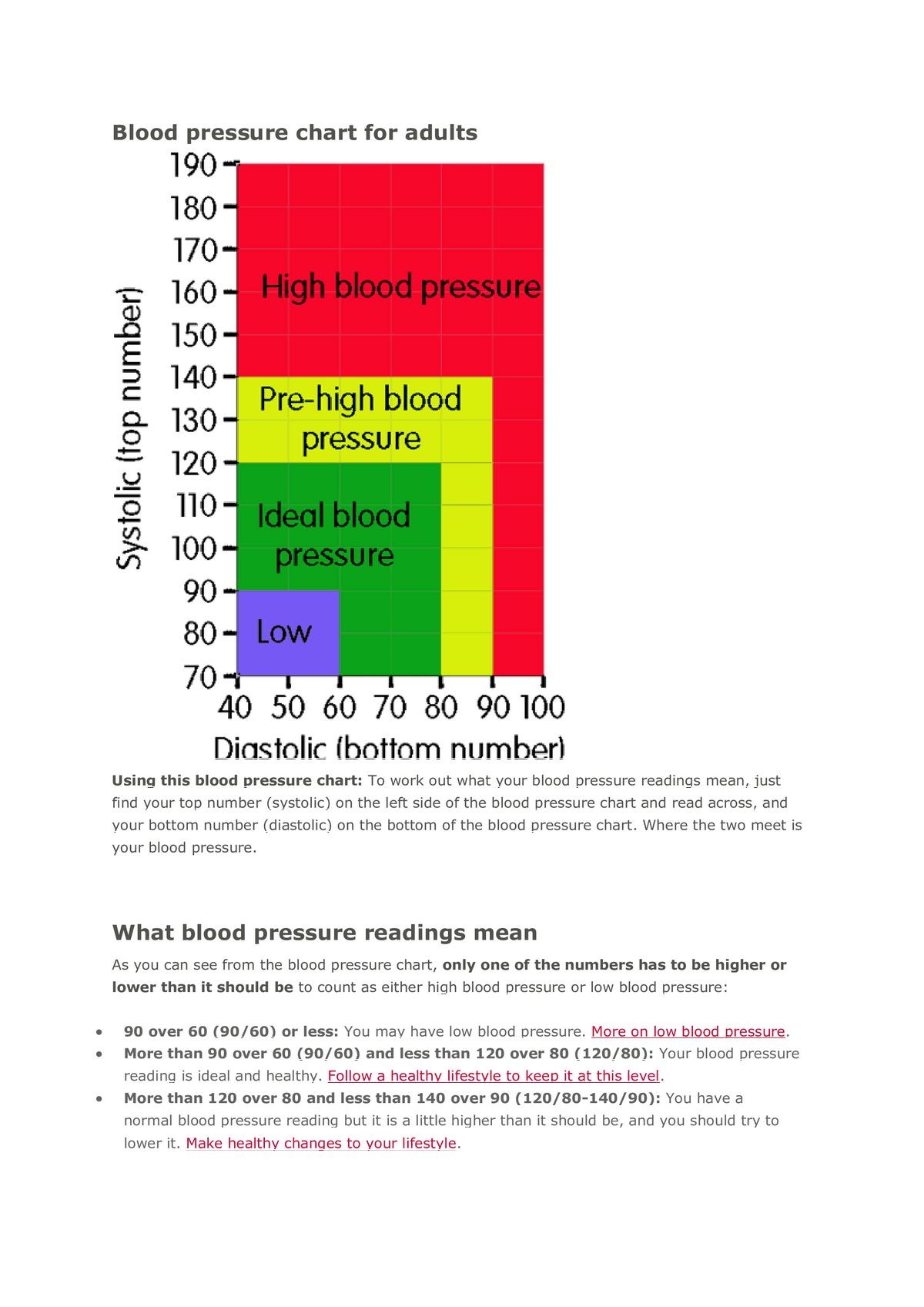
Blood Pressure Readings: Chart, Normal, High, Low
Blood pressure is categorized into five types: normal, elevated, hypertension stage I, hypertension stage II, and hypertensive crisis.
Blood pressure is the force applied by the blood on the inner walls of the arteries. The average blood pressure (120/80mmHg) remains constant but fluctuates throughout the day, decreasing when relaxing and momentarily increasing when excited or under stress.
It is primarily produced by the contraction of the heart muscle and recorded by two numbers.
- The first (systolic pressure) is measured after the heart contracts and is highest. It indicates the force of blood against the artery walls during heartbeats.
- The second (diastolic pressure) is measured before the heart contracts and is the lowest. It indicates the blood pressure at rest between heartbeats.
Therefore, blood pressure (BP) 120/80 mm Hg means 120 is the systolic number, and 80 is the diastolic number.
Which is more important: systolic or diastolic blood pressure?
Both systolic and diastolic blood pressure are vital indicators of heart health.
- Systolic blood pressure measures the pressure in blood vessels when the heart pumps blood.
- Diastolic blood pressure measures the pressure in blood vessels when the heart is at rest between beats.
Some doctors focus on systolic pressure as a major marker for heart disease in individuals older than 50. As you age, systolic blood pressure steadily increases due to the buildup of plaque and stiffness of arteries. Elevated systolic blood pressure increases the risk of cardiac and vascular diseases.
Both systolic and diastolic blood pressure can be used to diagnose high blood pressure. Recent studies show that the risk of death due to ischemic heart disease and stroke doubles with every 20 mm Hg systolic or 10 mm Hg diastolic reading.
Various factors, including age, diet, exercise, stress, and genetics, can influence blood pressure. Regularly check your blood pressure and work with your healthcare provider to manage it if it is too high.
QUESTION
What are the different blood pressure ranges?
A blood pressure cuff is used to measure pressure. High blood pressure is called "hypertension".
Depending on your blood pressure reading, you will fall into one of the blood pressure categories:
- Low
- Normal
- Elevated
- Hypertension stage 1
- Hypertension stage 2
- Hypertensive crisis
While many focus on the dangers of high blood pressure (hypertension), low blood pressure (hypotension) can also pose a threat. In cases of hypotension, a diastolic blood pressure reading of 60 mm Hg or below is considered low blood pressure. This is true even if your systolic blood pressure reading is 120 mm Hg, which is considered normal.
Your blood pressure measurement determines your blood pressure category. Higher readings increase the risk of certain conditions, such as cardiovascular and kidney diseases. High blood pressure can damage blood vessels, kidneys, and the brain if left untreated.
Blood pressure is categorized into low, normal, high, hypertension stage I/II (heart disease and stroke risk), and hypertensive crisis.
Blood pressure can be categorized into five types:
| ≤ 50 | ≤ 33 | A critical condition that requires emergency medical attention with IV fluids |
| ≤ 60 | ≤ 40 | Lifestyle modifications with medications |
| Less than 90 | Less than 60 | Lifestyle modifications and regular checkups |
| Less than 120 | Less than 80 | Active lifestyle |
| 120-129 | 80 or more | Doctors may recommend lifestyle changes at this stage |
| 130-139 | 80-89 | Doctors may prescribe blood pressure medications and lifestyle changes to reduce the risk of heart disease and stroke. |
| 140-159 | 90-99 | Doctors may prescribe a combination of medications and lifestyle changes; they may treat complications that may have increased due to high blood pressure. |
| 180 or higher | 120 or higher | A critical condition that requires emergency medical attention |
Blood pressure is measured in mm Hg (millimeters of mercury).
Contact your healthcare provider or Call 911 immediately if you experience the following symptoms:
- Shortness of breath
- Chest pain
- Back pain
- Numbness/weakness
- Change in vision
- Difficulty speaking
What are the normal blood pressure readings by age and gender?
The chart shows normal blood pressure according to age for both males and females, including Diastolic Blood Pressure (DBP) and Systolic Blood Pressure (SBP).
| 21-25 | 120.5 | 78.5 |
| 26-30 | 119.5 | 76.5 |
| 31-35 | 114.5 | 75.5 |
| 36-40 | 120.5 | 75.5 |
| 41-45 | 115.5 | 78.5 |
| 46-50 | 119.5 | 80.5 |
| 51-55 | 125.5 | 80.5 |
| 56-60 | 129.5 | 79.5 |
| 61-65 | 143.5 | 76.5 |
| 21-25 | 115.5 | 70.5 |
| 26-30 | 113.5 | 71.5 |
| 31-35 | 110.5 | 72.5 |
| 36-40 | 112.5 | 74.5 |
| 41-45 | 116.5 | 73.5 |
| 46-50 | 124 | 78.5 |
| 51-55 | 122.55 | 74.5 |
| 56-60 | 132.5 | 78.5 |
| 61-65 | 130.5 | 77.5 |
In 2017, the American College of Cardiology and American Heart Association updated their guidelines for men and women aged 65 or older to aim for a blood pressure lower than 130/80 mm Hg. However, as of 2022, the ideal blood pressure for seniors is considered to be 120/80 (systolic/diastolic), the same as for younger adults. The high blood pressure range for seniors starts at hypertension stage I, ranging between 130/80 and 139/89.
What time of day is blood pressure highest?
Blood pressure tends to be highest in the morning (morning hypertension) due to the release of stress hormones such as adrenaline upon waking up. This can cause an increase in blood pressure, possibly related to circadian rhythms and resuming movement after several hours of lying down.
Blood pressure is usually higher when standing up compared to sitting or lying down since gravity causes more blood to flow to the lower body. Physical activity, stress, and certain medications can also increase blood pressure. Consistently high blood pressure throughout the day may indicate hypertension.
Other factors that may impact blood pressure readings include:
- Physical activity: Blood pressure tends to increase during physical activity due to increased demand for blood flow to the muscles. It is generally recommended to check blood pressure before engaging in physical activity.
- Stress: Stress and anxiety can lead to an increase in blood pressure as the body’s "fight or flight" response causes the heart to beat faster and blood vessels to constrict.
- Medications: Some medications, such as stimulants and decongestants, can increase blood pressure. Discuss any medications affecting blood pressure with your healthcare provider.
By clicking "Submit," I agree to the MedicineNet Terms and Conditions and Privacy Policy. I also agree to receive emails from MedicineNet and understand that I may opt out of subscriptions at any time.
By clicking "Submit," I agree to the MedicineNet Terms and Conditions and Privacy Policy. I also agree to receive emails from MedicineNet and understand that I may opt out of subscriptions at any time.


